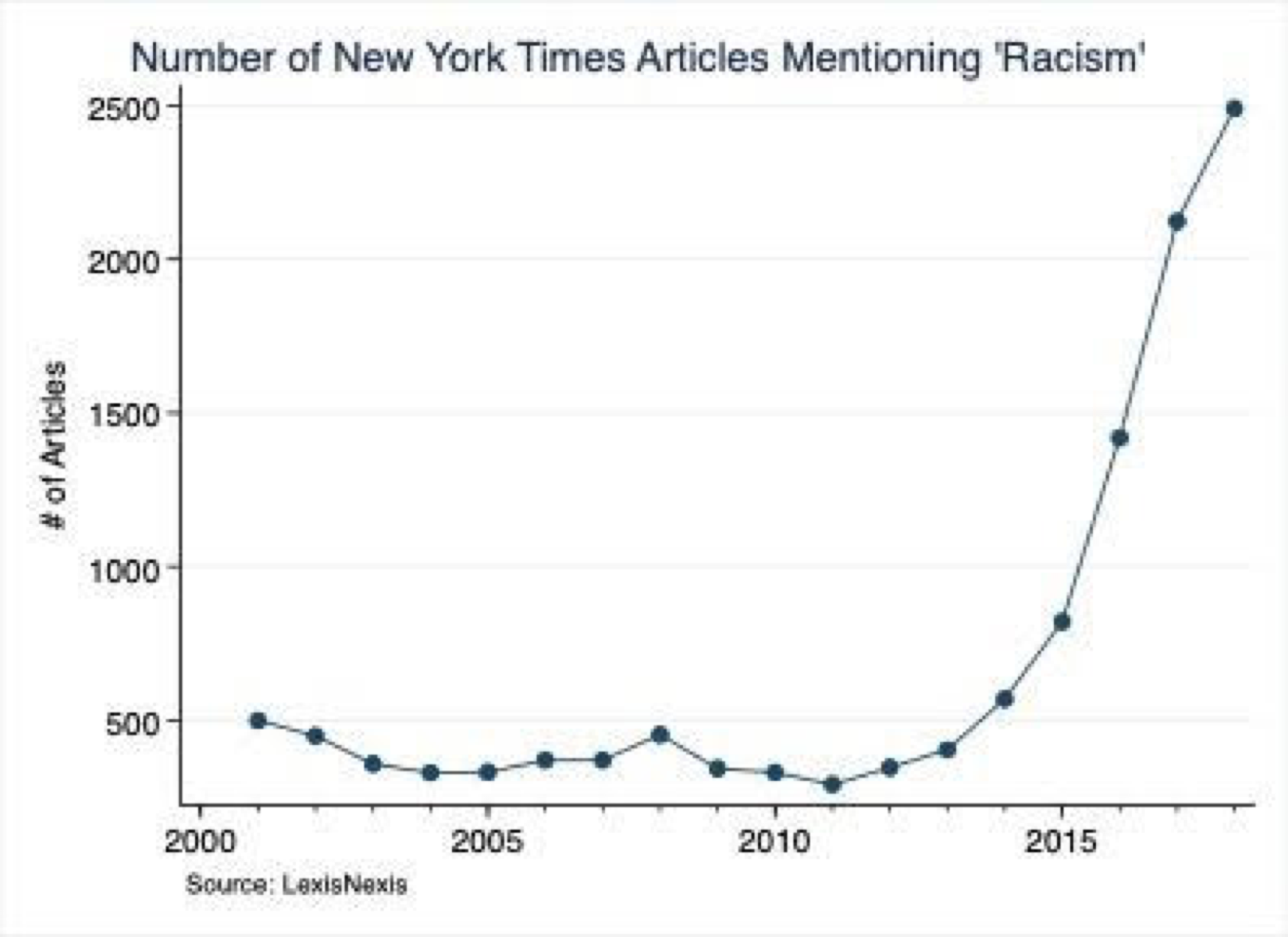Fascism, genocide, the Holocaust, Hitler, and The Handmaid’s Tale. Racism, white nationalism, and homophobia. Not a day goes by without charges and warnings about illiberal tyranny, looming oppression, and impending atrocities ringing through the public square.
On their face, charges of bigotry seem strange in contemporary American society. Rates of racial intermarriage are at all-time highs. Hollywood, higher education, and corporate America cheerlead for LGBT causes. Women make up a supermajority of university students. The leading problems, such as declining life expectancy, working-class failure-to-thrive, and populist anger at elites, have little or nothing to do with issues of bigotry and exclusion. Yet these charges not only persist, but increase.
And not just by a little bit.


No doubt these spikes in media fixation on white supremacy and racism reflect the fact that the incoming generations of reporters, columnists, and editors have been weaned on identity politics at every stage in their educations. The university culture’s fixations have entered the mainstream media, as this chart shows.

There are larger forces at work, however. Since the Civil Rights Act of 1964, the liberal establishment has anchored its power in the promise of minority (and female) empowerment and inclusion. This promise has inspired white liberals with a sense of a noble calling, and it has won the loyalty of minority voters.
The problem, however, is that as our society has become less racially divided, less judgmental about sexual orientation, and more enthusiastic about career women, the political potency of the promise of inclusion has diminished. This sets up powerful incentives for the liberal establishment to deny progress, citing the enduring—even intensifying—problems of “exclusion.”
In short, liberal power requires racism and other forms of bigotry. The loyalty of high-minded whites and minority voters needs to be renewed. The spike in articles about racism is therefore entirely predictable. White supremacy must be ferreted out and lifted up again and again in the media. When it can’t be found, it has to be invented—as in the case of Jussie Smollett, whose wanton lies were treated as necessary truths by the mainstream media.
There is another dimension to this power dynamic. Keeping racism, homophobia, and other charges of bigotry prominent in the public square suppresses dissent from liberal dominance. The same is true for charges of fascism or “far right” extremism.
Consider debates about immigration. The liberal media regularly reframes them in terms of racial politics. Those who object to mass migration are targeted as “white nationalists.” Those who insist upon assimilation are described as nostalgic for a white-majority nation. These rhetorical moves—tolerated, if not encouraged, by editors of liberal establishment newspapers like the New York Times and the Washington Post—function as threats. They warn dissenters that should they persist, they will be lumped in with Bull Connor.
In practical terms, this is not an idle threat. It implies professional assassination. A recent NYT op-ed issued that exact warning. “Similar to the way the American Medical Association has made it clear that its members must not participate in torture, the American Bar Association should signal that anyone who defends the border patrol's mistreatment of children will not be considered a member in good standing of the legal profession”—which is to say, those who support the administration’s policies will be “terminated” professionally.
Antifa thugs in Portland recently beat up Andy Ngo. It was an outwardly violent expression of the spirit of punishment abroad in today’s universities. Harvard law professor Ronald S. Sullivan, Jr., was not physically attacked. Instead, he was forced out as the faculty dean of a Harvard undergraduate house because student activists deemed his role on Harvey Weinstein’s defense team unacceptable. Professional assassinations of this sort are commonplace. The liberal establishment’s readiness to label as bigots anyone not fully loyal to its agenda implicitly authorizes these actions, which now take place in many professions and corporations.
The atmosphere of threats affects conservatives, as was obvious when some prominent conservatives rushed to condemn high school students from Covington, Kentucky, whom social media set up as racist Trump supporters. The impulse was understandable. The conservatives wanted to insulate themselves from professional assassination by proving their loyalty to the anti-racist imperative.
A similar dynamic characterizes the charges of theocracy, fascism, and other illiberal crimes in public debates about the future of our country. Not far beneath the surface is the threat of prosecution at latter-day Nuremberg trials. Labels of this sort, especially fascism, target careers and livelihoods. This explains why so many on the right anxiously seek to find safe ground whenever charges of illiberalism or bigotry are made.
I was a child in the racially divided city of Baltimore when the historic civil rights legislation passed. I grew up knowing exactly what racism meant, having friends and parents of friends to whose lips the N-word came easily—and who had sentiments that accorded with that derogation. Baltimore remains racially divided, but “anti-racism” has come to mean almost the opposite of what it meant in my youth. Black empowerment and racial reconciliation are afterthoughts, at best. Today, anti-racism, like anti-fascism, anti-homophobia, and other crusades against bigotry and exclusion, is first and foremost an instrument of attack and assassination that serves the interests of liberal power.
R. R. Reno is editor of First Things.
Like First Things on Facebook, subscribe to First Things via RSS, and follow First Things on Twitter.



